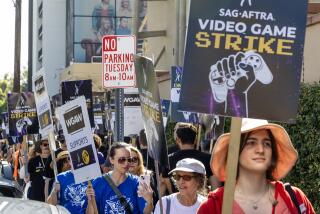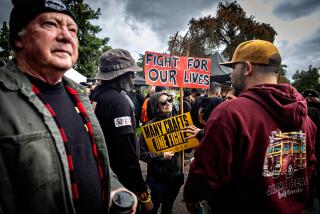Little Progress Made in NHL Labor Talks
- Share via
The first large-scale meeting in nearly seven months between executives of the NHL and the NHL Players’ Assn. ended Thursday with no sign they are closer to resolving their economic differences and averting a lockout next season.
Bill Daly, executive vice president and chief legal officer of the NHL, said there was “no real movement on the big issue” during a 3 1/2-hour meeting at the union’s Toronto office. Daly and Commissioner Gary Bettman were the league’s chief negotiators; Bob Goodenow, executive director of the NHLPA, and Ted Saskin, the NHLPA’s senior director of business affairs, headed the contingent representing the players. They had last gathered Oct. 1 in Toronto.
The current labor agreement expires Sept. 15. League officials and club owners, claiming they lost $273 million last season and can’t continue to spend 76% of revenue on player costs, have said a new agreement must include “cost certainty” and that they will endure the short-term consequences of a lockout to get long-term economic relief. The union interprets “cost certainty” as a salary cap, which it categorically rejects.
“We had a good, candid discussion of our philosophical issues and our views,” Daly said Thursday by telephone from Toronto. “In that respect, it was positive. The more dialogue you have, the better.”
Saskin agreed the session was useful but saw no progress.
“We had dialogue [but] there is no change in position from the NHL. They came and wanted to talk about a salary cap,” he said. “They know that’s not something that will lead to agreement. At the end of the day, nothing is really new....
“I don’t think there was any indication they were prepared to compromise.”
Daly described the session as “cordial” but said they won’t reconvene today, even though they had set aside time for more talks. However, they kept their plan to meet again May 24-25, and the principal negotiators will talk in small groups before then.
“I’m going to be in Europe, at the world championships, with Bob, and Gary always spends time with Bob when they’re in the same city,” Daly said. “We’re going to continue our discussions. Both sides are committed and want to get something done.”
The current labor deal is the product of a lockout that cut the 1994-95 season to 48 games. It was extended in 1995, in conjunction with an agreement that allowed players to participate in the 1998 Nagano Olympics, and again in 1997, as part of a four-team expansion.
The NHL says players’ salaries grew 252% from 1994 to 2004 while its revenue grew at a rate of 163%. “I certainly don’t want to have a fight,” Bettman told a gathering of newspaper sports editors last week in New York. “The fact of the matter is we don’t have a choice. We have to fix our problems.”
The union disputes the league’s data, saying that by directing revenue to related entities, owners can report an operating loss on their clubs but profit in areas such as parking, concessions and luxury suites.
The union and agents have counseled players to set money aside in case they are locked out in September. For its part, the NHL has asked each club to contribute $10 million to a fund that could be tapped for operational expenses if arenas go dark.
Saskin told the sports editors’ gathering last week: “The NHL is prepared to shut down for the Holy Grail, a cap system.”
More to Read
Go beyond the scoreboard
Get the latest on L.A.'s teams in the daily Sports Report newsletter.
You may occasionally receive promotional content from the Los Angeles Times.








